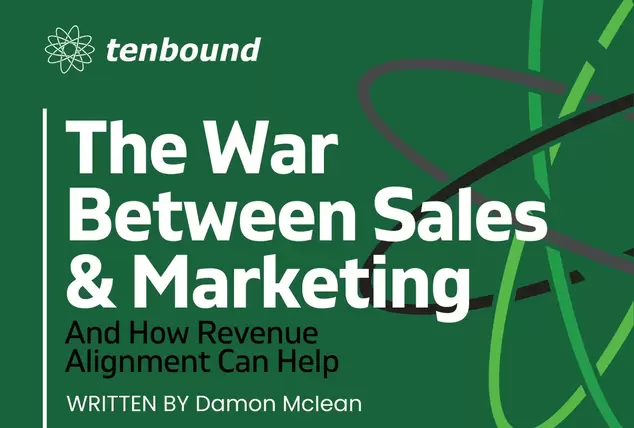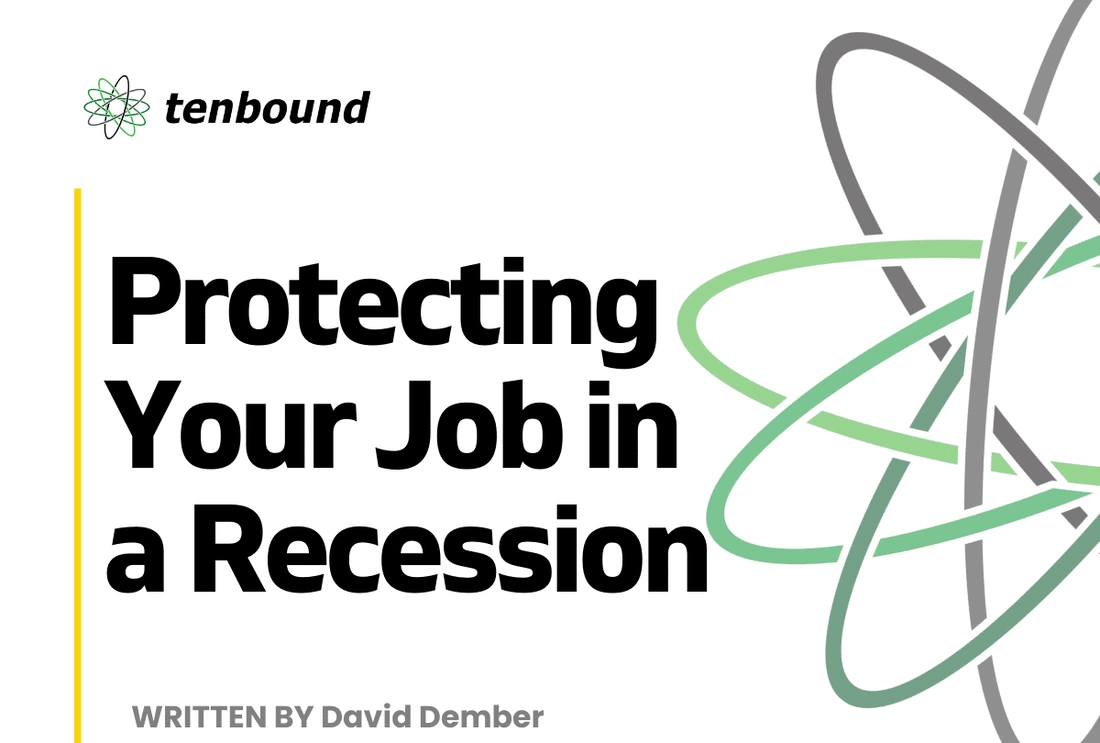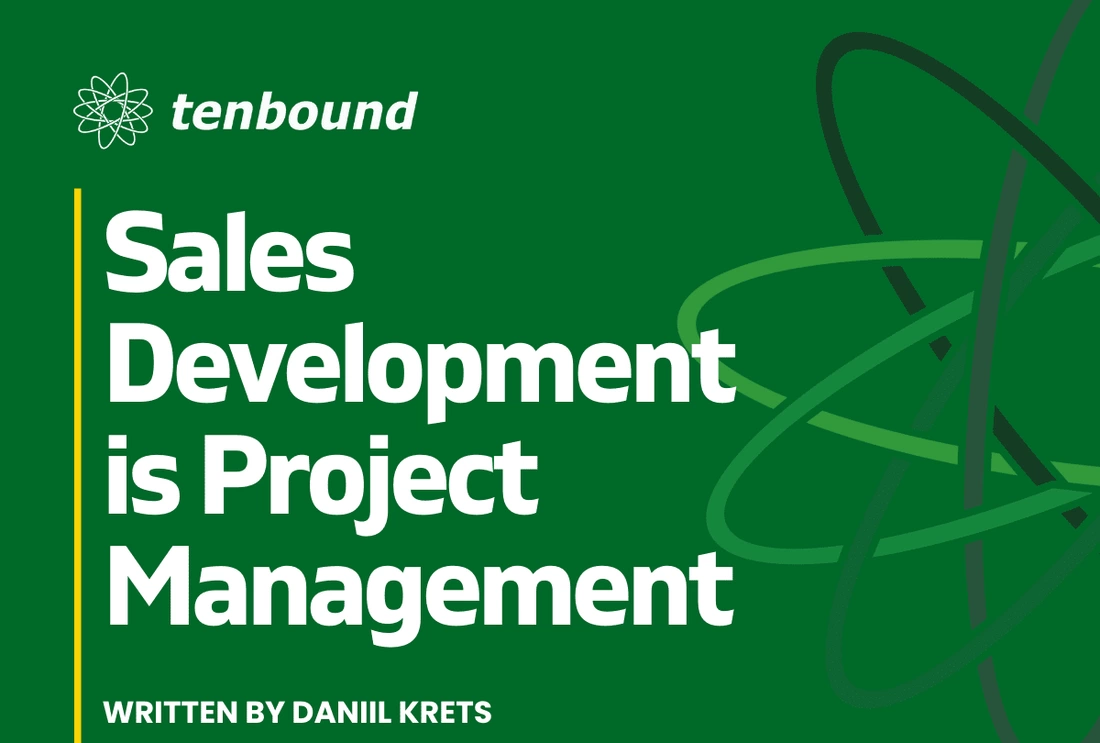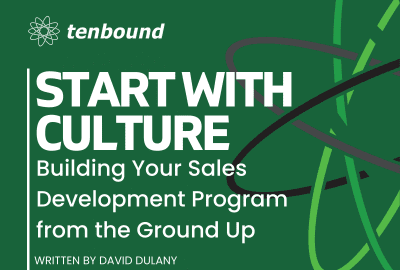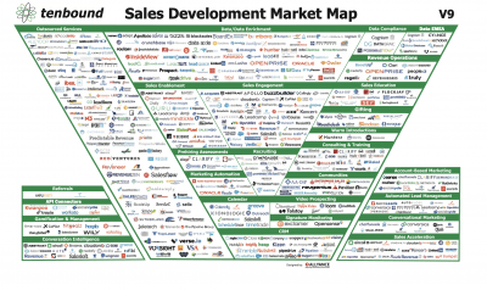What to expect from Tenbound’s Revenue Alignment Conference on September 8th, 2022
8/5/2022
Comments
We are excited for the upcoming Tenbound Sales Development Conference focused on Revenue Alignment. So much so that we've decided to share 4 of the top pieces of advice from the last 3 years around this important topic.
1. How to position SDRs as the most critical role in the revenue operations Don Otvos shared his strategy for coordination with the Sales Development team and why it is critical to the success of his overall RevOps strategy. 2. Driving Revenue Alignment through Sales Development David Dulany from Tenbound, and Kyle Coleman, SVP of Revenue and Marketing at Clari, covered the tenants behind driving Revenue Alignment through Sales Development. Throughout the conversation, the duo unveiled the key forces that empower leading organizations to accelerate sales and revenue growth. They discussed 3 Key Factors that Drive Revenue Alignment: 1. Cross-Departmental Coordination 2. Looking Down the Funnel 3. Onboarding Unique Perspectives 3. Why You Should Build Your Go-To-Market Team Around Your Customer’s Journey Most GTM teams are still contained in individual units or struggling to communicate with one another to discover the customer journey. Without a deep understanding of the customer journey, it’s difficult to align to provide the value customers expect and to provide a seamless experience. To ensure success with your product or service, building your go-to-market team around your customer’s journey is key. 4. What is a Chief Revenue Officer? CRO Darryl Praill and Tenbound CEO David Dulany sat down to break down how a CRO should operate today - highlighting how to unify marketing, sales and success into one coherent Revenue unit. Join the Top Minds in Revenue Alignment on September 8th at Tenbound’s next Virtual Conference! At this Free event we’ll be covering everything you need to rev up your cross-functional, go-to-market teams by synchronizing pipeline and revenue generation. Attendees will learn from top names in the industry on a strategic and tactical level how to actually do Revenue Alignment vs just talking about it. Focusing on alignment can increase pipeline and revenue, and enhance their careers as revenue professionals. For more info and free registration click here. It’s no secret that marketing and sales have been wrestling to be on the same page for a long time. Recently, Linkedin released research that showed that up to 90 percent of sales and marketing professionals believe that they don’t have alignment.
With many working parts working concurrently to generate business success, solutions for consistent low revenue can be hard to address. A great solution to resolve any operational flaws is to analyze its Revenue Alignment strategy. What is Revenue Alignment and Why Does It Matter?It’s the optimal coordination of the different departments that make up a business: Sales, Marketing, Finance, Support, etc. Revenue alignment places the customer at the center of their priorities by directing all teams to have the primary goal of their complete satisfaction. Research has shown that revenue alignment can drastically increase win rates. ● Alignment can lead to a 32% increase in year-over-year (YoY) revenue growth. (Aberdeen Group) ● Alignment can lead to 38% higher sales win rates. (MarketingProfs) Now that we covered what revenue alignment is, let’s discuss ways we can accomplish this across departments. How to ensure there’s alignment across departments: Marketing Aligned marketing entails focusing on the problems that your business’s solutions solve rather than advertising lists of product details. As a business, you must be transparent and openly acknowledge any lapse in service or product faults. Marketing must prioritize the preferences of the target consumer base and leverage these desires to attract new business. Sales Aligned sales mean consulting customers on the exact ways a product can be used to address their pain points. They must often communicate their observed customer preferences and perceptions of the company internally. Finance Aligned finances require all payment and customer persona data to be analyzed and organized to provide insights to the rest of the company. This data informs the organization on user habits, changes in activity, and other shifts as a result of outside or internal factors. Customer Success and Support – For Customer Success to align, they must ensure customers are able to make use of your product or service as promised. Success representatives should also monitor customers to ensure that the use of your product or service has a significant, measurable impact. Support representatives should be sincere in their appreciation of a customer pointing out an issue and seek to resolve it as quickly as possible. Identify and find solutions for customers experiencing difficulties or weak points in their end result. How to measure your revenue alignment strategies? Revenue Alignment focuses on creating and analyzing measurable data from each department to deliver influential solutions that greatly benefit customers. OKR (objectives and key results) systems can be implemented to aid in zeroing in on the most vital misalignments to tackle. To tighten the alignment of the ultimate business goals and outcomes between each department of the organization, OKRs show individual teams how their work impacts overall operational outcomes. OKRs cannot substitute strong executive leadership or creative work, but can aid in guiding the organization to higher certainty of revenue success. OKRs are a great way to plan objectives in QBR (Quarterly Business Planning) sessions. They encourage agreement across departments in order to align collectively towards a common goal. OKRs enable departments to easily communicate the identified misalignments or errors with the rest of the organization as they provide quantified observations. The structure and clarity provided by OKRs make the impact of aligning the operations in the organization more visible. When adapting the alignment of your organization to achieve predictable revenue growth, OKRs can play a great role in monitoring the operational efficiencies between departments. Want to learn more about how to bring alignment across the different departments? Join the Top Minds in Sales Development and Revenue Alignment at the next Tenbound Virtual Conference on September 8th diving into the greatest of go-to-market challenges – driving true Revenue Alignment! With the recent headlines of layoffs and hiring freezes, there is growing economic uncertainty and anxiety about a potential recession. In a recession, job layoffs and hiring freezes are routine as inflation rises as budgets vanish.
Employers prioritize keeping high-performing representatives with track records of considerable achievements, especially those with prior history of high performance in difficult times. This leaves lower performing or newer candidates as the first representatives to go. Although much of these circumstances are outside of your control and depend greatly on luck and politics, there are still a few things that you can do to best prepare and position yourself for the upcoming downturn. Here are a few: 1. Cultivate the Right MindsetSaaS startups are getting especially hard with the current inflation levels, rising interest rates, and geopolitical issues. Valuations, particularly at the late stage, have started to dip, and startups say it’s more difficult to raise new funding in this environment. Investors are less willing to get involved with new businesses that have not consistently turned a profit, which leaves most startups in a less favorable position. This may sound overwhelming but it is important that you do not let this bad news consume your thoughts. You have a choice whether you do or do not to dwell on things that are out of your control. You must act with a survivor mentality. A survivor mindset helps you focus on everything that you can take action upon and in turn stay positive. Rather than listening to the radio while you’re cruising into work, listen to something motivational like Dr. Eric Thomas or Kobe Bryant – The Mindset of a Winner! 2. Play OffenseIt’s not the time to hunker down. If you get on the defensive, you’re dead in the water. Instead, use the time to reevaluate your goals and position yourself to be in the best possible place as layoffs come around. As a survivor, you must pay attention to any possible potential pivots or opportunities that can put you on the best side of your boss or clients. Seek out ways to create more value for your business or personal brand. While others are hoping to keep their job, you’re setting the goal to become irreplaceable and valuable as possible. 3. Focus on the Right OpportunitiesA challenging economy tends to shake up the job landscape. We have seen that first hand with all of the layoffs via our LinkedIn feed. Anytime your feed goes off, you’re likely wondering if more jobs are getting cut. But let’s not forget how it could be used for our benefit. Focus on leveraging your intent data to find companies interested in your product. Don’t just throw your prospects in sequences. Instead, be mindful, intentional, and seek to truly understand their daily challenges. Paint a picture of how your solution will help them create additional efficiencies internally and become a master storyteller. 4. Edit your resumeEven if you do everything right, there’s still a chance you will be laid off. I hate to even put that out in the universe, but you can’t be oblivious to reality. Founders and investors are preparing for what looks like an economic downturn – and perhaps even a recession. So, you have to plan and prepare for the worst. This preparation will ease any strain in quickly transitioning to job-hunt mode. This is a great time to focus on networking through LinkedIn with recruiters, career coaches, and catching up with former coworkers. Tips for discussing being laid off: ✅ Mention it in your cover letter: Future employers should be made aware of your reason for searching or hoping to transition to another job. Your cover letter serves as the best place to break down your history and the circumstances of your layoff. Providing this information up-front may also help you stand out from other applicants with similar experience levels. ✅ Speak positively about the organization: Do not mention anything negative about your prior workplace. It is alright to mention vaguely that it “was not a great fit.” Anything beyond that is not professional and can leave a bad taste in others’ mouths. ✅ Highlight what you’ve done since: Highlight your resilience and everything you have done to push through tough times. These accomplishments represent a great work ethic, positive outlook, and motivation to overcome any obstacles thrown your way. 5. Uplevel your skills with communityA recession provides a great time to head back to school, learn new marketable skills, start side gigs, join industry communities, or pivot into a new career. A community that assists and supports you through this process is Tenbound Plus. Tenbound Plus is a VIP Membership Community 100% committed to your success. If you’re one of the folks that have been affected by a layoff and are concerned about finding another job, do not hesitate to book a consultation with David Dember of Tenbound. He will assess your situation, identify alternate paths, and walk you step-by-step through the process of finding a new job. To aid in supporting you through this process, Tenbound provides an insightful community forum. The community forum provides a great place to assess the current atmospheres of different realms of the Sales Development Space. Last quarter we helped 57 SDRs find new work and it is our top priority to help and support you through this uncomfortable process in any way possible. Start Receiving These VIP Benefits Today Get VIP Access Private Peer-Led Community ForumEngage with our VIP community of experts and leaders in the Sales Development space. Live Weekly Tool Advisory CallsWeekly live and recorded calls discussing the latest Sales Development tech & tools. Live Weekly Group Leadership CallsWeekly live and recorded SDR Leadership calls to increase your teams’ pipeline and revenue. Sales Development Framework Print BookPrint copy of “The Sales Development Framework” book to build & scale your SDR program. Discounted Conference TicketsReceive heavily discounted event tickets to all Tenbound Sales Conferences Live Weekly Coaching CallsWeekly live and recording Rep Management calls to increase team productivity and leads. SDM & SDR Training ModulesInstant access to our online self-paced SDR Manager training course. (Worth $690). Tenbound Market Map Tools & ServicesThe Top Tenbound Market Map tools & services to take your SDR program to the next level. Premium Sales Development DocsOur best selection of Frameworks, Surveys, Templates & Research Reports to simplify your processes. Tenbound Plus helps you answer the questions that plague Sales Development Leaders: ✅ How should I train and coach my team? ✅ How do I work cross-departmentally? ✅ Should we focus on inbound, outbound or a hybrid model? ✅ What’s the next step in my career after Sales Development? ✅ How do I negotiate and build Executive presence? ✅ How do I build Business acumen? ✅ What’s the next step in my career after Sales Development? ✅ And so much more…. Join today to start working with your peers and the Tenbound team to further your success! Get VIP Access How to Protect Your Job in a Recession Guest Post by Sales Development and Project Management Pro Daniil Krets
Knowing how to run a good process has unquestionably been helpful as a manager, and it was also a force multiplier when I was an individual contributor. Before focusing on building a career in Sales Development, I’ve been super passionate about Project Management. I ran complex projects in fintech for years before moving to the US and making a transition to sales. I even secured a PMP certification back in 2016 which I’ve been finding extremely valuable ever since. For example, as an SDR, whenever you have a slow week and ask your manager how to bounce back you’re most likely going to get a similar answer every time: trust the process. This is why the process is so important in Sales Development. The essence of Sales Development is building a repeatable, measurable, and predictable process that scales with the business. In this blog post, I will dive into the key knowledge areas of Project Management and how they align with Sales Development. I will provide examples to highlight some of the key components of a successful sales development strategy and what SDR Leaders need to focus on to build a good process. What does Project Management have to do with Sales Development? Actually a whole lot. If you run a basic search on key knowledge areas the waterfall Project Management methodology focuses on, the list is going to look like this:
Let’s see how each one aligns with Sales Development. By doing this, we will unpack the similarities and see how project management skills are relevant in sales development and identify the top 3-5 most important “project management components” of sales development an SDR Manager should polish to be successful. Let’s dive into each individual component:
Another component that stands out when I think about this knowledge area is integrating and defining the scope of Sales Development within the organization. As an SDR Leader, you have to be a bit more involved in sales and marketing than you’d like to because you’re sandwiched between the two parts of the funnel and the state of both heavily influences your performance and what ultimately your “project” needs to look like.
What does this mean? The SDR Manager job is increasingly becoming more about running a good scalable and measurable process, rather than about getting the messaging out there and making sure the results are good enough. The job is becoming more and more complex as the function matures in the business world and becomes a key component of the GTM strategy for a lot of organizations. I’d argue that at this point, the job is probably done best by a group of people, rather than one person. Some “projects” are very different jobs by design and it’s difficult to find a unicorn SDR Manager that does all of them well. Some are better people leaders (or cheerleaders) than others, some are focusing on strategy, tools, and process more than anything else. Both are good options but for different stages of Sales Development function maturity and the type/stage of the organization. Right now, we’re seeing SDR Enablement and Operations emerging as new, separate functions within SDR organizations and this is a sign of the function evolving and becoming more complex. This proves my point about the fact that this part of the funnel, being run by one person with no support and resources, the way it used to years ago (but still being the case quite a bit today), is unscalable or impossible. The areas to master will be different for each individual SDR manager but being self-aware and identifying the key areas of growth is extremely important for career development and growth. Communities and resources like Tenbound help accelerate this growth and learn from past mistakes and experiences. Networking and having mentors are key drivers that helped me grow as a professional and a leader faster which I’d highly recommend to any new SDR Manager. To sum things up, the most important project management areas to master as an SDR Leader from my perspective are Risk, Resource, Communication, Quality, and Stakeholder management. Coupled with an ability to run a good process, mastery within these areas guarantees a long and successful Sales Development Leadership career. When it comes to cold calling, you’ll find plenty of books that seem to think it takes 200 pages to properly capture the art. But just like an actual cold call, brevity is the soul of success. That isn’t to say longer calls don’t provide ample opportunity for closing, but it does mean you need a plan in place to encourage a targeted dialogue before the close. And the best part? You don’t need 200 pages to learn how to do so.
Whether an account or marketing executive, cold calling in software sales is a necessary tool to truly stand out and be a top performer To assist with that, we’ve compiled all of the best cold calling tips into one Definitive Guide to Cold Calling. So let’s kick it off by starting with: Understanding the Cold Call Data Across the years, sales books have gathered numerous statistics on the efficacy of cold calling. They have addressed its decline in popularity from the dot-com era but also acknowledged its necessary place in today’s world of selling. As it stands, sale conversions from solid leads round out to about 18%, with leads from referrals around 50%.[1] Cold calling is left with a seemingly paltry 2%.[2] Does that mean it’s a strategy that should be left in the past? Definitely not. But it does mean that the methods for successful cold calls are far more refined than simply dialing numbers all day long – even if persistence is still key here. Let’s take a deeper look at some stats. More calls always increase conversion and contact rates. The 6th cold call attempt often reaches 93% of converted leads, and 50% of buyers could use a follow-up call.[3] 80% of sales generally require five follow-up calls.[4] When it comes to B2B sales, specifically, 57% of C-level executives prefer a phone call, as well as 51% of directors and 47% of managers.[5] Right about half of all salespeople consider their phone to be their most effective tool, and cold calling continues to show its value as the most effective prospecting strategy – so much so that organizations who believed that cold calling is no longer effective experienced 42% less growth than those who did.[6] It’s also important to note that 69% of modern shoppers accepted cold calls this past year, which, perhaps more than any other statistic mentioned, means it’s time to utilize[7]: The Cold Call Cheat Sheet With all the sales jargon out there, we can forget the fact that we're simply looking for a human connection in every cold call. Having a cheat sheet to remind you of the basic courtesies of conversation ensures the most bookings over the long term. This all starts with four basic rules: 1) Prepare & Prospect Before the Call To convert a cold lead into a warm lead, you need to know everything you can about who you’re calling in the first place. Do I know their interests? What is my objective? What are ten questions or pieces of information I can readily offer on my product? Am I calling at the best time? To answer the last, based on 25,000 sales calls, weekday afternoons were found to be the best time.[8] It’s also important to keep a few other averages in mind, such as: 22.5 dials bring about 1 meaningful conversation 30 dials bring about 1 meaningful conversation for the IT, marketing, and senior executive 3 meaningful conversations are needed for 1 appointment[9] 2) “How Have You Been?” & Voice Training It’s easy to think because of that short window for a hook, you need to jump right into the pitch – but never underestimate the value of a friendly greeting. This particular question boasts a 10% success rate compared to a 1.5% baseline.[10] In that greeting, also avoid asking who you’re speaking to, whether it’s a good time to talk, and otherwise excusing yourself for the intrusion. Another thing to keep in mind here and throughout is voice training, or the three techniques to most be mindful of in conversation: pace, tone of voice, and volume.[11] 3) Start Proactively: Sell the Reason & Not the Exploration After the pleasantries are exchanged, don’t be afraid to take charge. Know your pitch and why your product has an advantage, but also prepare for how to navigate the most common objections like: “Send me an email” “Can you call back later?” “I am going to have a meeting with our management on this; let’s talk next…” Most prospects have a reason for taking a demo call. Often it's to learn something new, see how they compare to other executives in their industry or evaluate if your product can solve a problem they have now. If you learn these fundamental reasons, you'll be able to sell the benefits of this instead of the exploration. 4) Educate the Buyer & Lead the Conversation – Don’t Control It 84% of buyers complain about sellers who launch into a pitch too early without understanding what the prospect is actually looking for.[13] Also, if you jump the gun on the pitch without first understanding who you’re speaking to, you might get caught up with the gatekeeper rather than the decision-maker. When pitching, every sentence needs to lead the listener to the next. You are a problem-solver and a consultant at the same time. The prospect should be educated on a product sequentially based on their own understanding, not yours. Ask open-ended sales motivation questions as you would in everyday dialogue, not yes or no questions to stagnate the flow of conversation. Your goal is to guide them through the conversation, not controlling it to make it to the close faster. Dealing with Phone Anxieties & Managing Time Effectively Those tips can help during a cold call, but only continued practice can help us overcome the fear of rejection. Success in cold-calling is found at the intersection of quality in quantity. In that way, it’s a numbers game that takes time to master. “Some will, some won’t, so what.” We don’t take rejection personally – we set our insight towards learning something new on every call. With this It can be daunting to pick up the phone from time to time, however, the best way to get over anxiety in cold calling is through conversion. It reaffirms to you that this method can work, and you can do this. To that end, leverage technological tools to remove tedious tasks so that you aren’t wasting time between calls. Prepare and research to create a prospect list with more opportunities, and don’t let yourself get bogged down in a routine of reading a script like a robot. Keep a schedule that emphasizes impact and practice voicemails that entice a prospect’s attention. Pulling it all Together As with any skill, cold calling necessitates knowledge and experience, by combining these tips and tools, you will see your cold calls begin to build conversions. Combining an in-depth understanding of your product, including any caveats and nuances, as well as the experience of how best to navigate objections and manage your time efficiently. With this guide, we’re confident you can do both. We hope you found this article helpful, and we can’t wait to hear how you implement it on future calls. For all things Tenbound, keep an eye out for our newsletter and check out our channel for more tips! [1] Jay, A. (2022, January 14). 64 cold calling statistics you must learn: 2021/2022 Challenges & Data Analysis. Financesonline.com. Retrieved May 3, 2022, from https://financesonline.com/cold-calling-statistics/ [2] Ibid [3] Ibid [4] 05, J., 24, S., 11, M., & 22, F. (2022, March 4). 7 detailed cold calling tips, statistics, and ways to improve conversions. SalesIntel. Retrieved May 3, 2022, from https://salesintel.io/blog/7-detailed-cold-calling-tips-statistics-and-ways-to-improve-conversions/ [5] Ibid [6] 64 Cold Calling Statistics - https://financesonline.com/cold-calling-statistics/ [7] Ibid [8] 5 no-nonsense cold calling tips. Sales Assembly. (2022, February 11). Retrieved May 3, 2022, from https://www.salesassembly.com/cold-calling-tips/ [9] ZoomInfo. (n.d.). The B2B cold calling guide: The pipeline: ZoomInfo. Pipeline Blog. Retrieved May 3, 2022, from https://pipeline.zoominfo.com/sales/being-cool-to-cold-calling [10] Gong.io/blog. (n.d.). Cold Call Guide. https://pages.gong.io/wp-content/uploads/Cold-Call-Guide.pdf?mkt_tok=MTg1LVZDUi02ODIAAAGD3fHm6fnDhjR98g3ZDNZvOkhlsEw5CF1VcCgObfxQuuVM6OJ2FiVBOQVk1nkQgF614wC_tEAgf2Fxnw4Rr76ImswKxvtBVjK-vkmgIEofOA [11] Patel, S., Sujan Patel (2020, June 23). How to train a new salesperson on Cold calling. CloserIQ. Retrieved May 3, 2022, from https://www.closeriq.com/blog/2020/02/train-sales-reps-on-cold-calling/ [12] Holovnenko, A., Anastasiia Holovnenko - The Coolest Cold Calling Guide - Tips & Tricks That Work. Retrieved May 3, 2022, from https://www.cience.com/blog/cold-calling-guide [13] 05, J., 24, S., 11, M., & 22, F. (2022, March 4). 7 detailed cold calling tips, statistics, and ways to improve conversions. SalesIntel. Retrieved May 3, 2022, from https://salesintel.io/blog/7-detailed-cold-calling-tips-statistics-and-ways-to-improve-conversions/ SDRs: How to Double Your Reply Rates
6/24/2022
We all know how difficult it can be to elicit a response from a potential prospect.
Regardless of experience level, the universal struggle of getting that sought-after reply is why there are so many tactics, guides, and strategies detailed from countless sources. But while those delve into philosophy and theory, they aren’t grounded by data-driven results. That’s why we sat down with Becc Holland, CEO & founder of Flip the Script, and Jeremey Donovan, former SVP for Sales Strategy at SalesLoft, for a conversation on what works and what doesn’t for sales-prospecting in today’s market. Holland has spent years researching the most effective methods of outreach and she has developed a modern, data-driven approach that provides a clear framework for success. While the entire approach can’t be contained in one webinar, the foundation of it is built from the very first contact. That’s why Holland outlines the three hooks designed to double reply rates: 1) The Problem-Centric Personalization Your hook is your opening line, and a Problem-Centric, personalized hook is a 1:1 approach. It means you choose one problem, one person, and you craft your pitch directly to them. There’s no 1:2 or 1:20; this is a fundamental plan, either defined as public-facing or customer-persona, that means interacting and selling into a company that directly relates to the services you provide. Problem-Centric Personalization hooks are all about problem-solving: setting up a scenario, giving insight to shortcomings, and providing a tangible, practical solution. It lets you identify and relate with a client, highly-personalize your approach, and clearly communicate the path forward. The only downside of this is that it requires the company you are selling into to offer a client-side service that you can access. That’s why the other two hooks are available: to ensure you stay adaptive: 2) The Strong Hook Strong and light hooks are two sides of a similar approach. A strong hook is the forward approach. It’s using information available to you (for example, researching someone’s LinkedIn); you identify an interest or need, and sell your service specifically to meet that. The benefit of a strong hook is that it’s no longer 1:1; it’s 1 to the company at-large. It’s a problem-solving solution not limited to companies with client-side services, but companies and individuals that might be part of larger networks. 3) The Light Hook By comparison, a light hook is a bit harder to land, but can be extremely effective for the right person. It requires you to draw a more conceptual tie between a prospect’s interests and your services. Holland gives the following example, “Jeremy played basketball at Sandford…and I am likening that to software like SalesLoft. What if you could turn all of your bench players into your starting lineup by enabling them with the techniques they should be practicing on and off the court…” The light-hook, in that way, connects a tangential problem to a general solution. It may not be enough to land the sale, but it’s plenty to get the conversation started. Pattern Interruptions & Transactional Ego States Beyond the hooks, Holland and Donovan also discussed the importance of Pattern Interruption and its relation to the three ego states conceptualized by Eric Berne in his famous book, Games People Play. Pattern Interruption, Holland says, is your key to breaking free from the stigma and awkwardness of the “salesperson/buyer” relationship. This can take the form of an understanding and candid demeanor, or simply emphasize listening and conversing over aggressively pushing your services. Knowing how to tailor your Pattern Interruption is important, because it can help you to properly understand and react to a person's “Objection Matrix.” To do that, Holland says you ask two questions regarding someone’s objection: Is it real or shallow? Is it valid or invalid? A real objection is something a prospect fundamentally believes, while a shallow objection is an initial distrust in you. The key takeaway is that you can wade through the shallows, and an objection can be both real and invalid. For instance, a prospect may sincerely believe they are correct in their objection but may be factually wrong. Holland makes the important note that all shallow objections are invalid, and are a prime opportunity to counter with pattern interruption. Understanding the theory and principles of modern sales outreach is critical to doubling response rates – and that all starts with knowing Hooks and Pattern Interruptions. If you found this summary interesting, the full discussion between Becc Holland and Jeremey Donovan can be found in this YouTube video. And for all things, Tenbound, keep an eye out for our Newsletter and take a look at our other helpful videos on YouTube. There’s something to be said for chemistry.Arbitrarily throw people together and the results will be mixed. But actively seek out like-minded and complementary individuals, and you're launching from a place of success. Shared values, beliefs, and goals are the cornerstone of any strong organization, and that’s equally true for a romantic partnership, sports team, business endeavor…
Or Sales Development program. Start with core values and behavior. That’s your team culture, and it will literally determine and influence everything else. “Culture eats strategy for breakfast.” ~Peter Drucker It’s easier to find employees and build processes that align with your culture than it is to force existing ones that just don’t fit. Round hole, square peg. Work smarter and start with culture. Craft Your CultureToo often, corporate culture is implied rather than explicitly defined. We need to change that. We need to identify it, write it down, and share it with every stakeholder within your company, department, or team. Aside from making your job easier, an established culture can account for up to 20-30% of the differential in performance when compared to your competitors with no clear culture. Can you afford to ignore that? Your first job as a Sales Development leader is to create and drive a strong culture. The Building BlocksAsk yourself and your team:
Make a list together, either in person or collaboratively online. Distill it down to no more than 4-6 with a one sentence description for each. Write them out. You might list collaborative, for example, adding that you work together to reach team goals irrespective of personal accolades. Next, consider your ideal employee. What attributes do you see in your existing team members, and want in your future hires? Write them out. Finally, think about your leadership style. How would the team describe it? Does it align with the culture you’re building? What do great leaders do on a daily basis? Write it out. You now have the necessary building blocks. Draft Your Culture StatementA culture statement is similar to — and may even include — your mission statement. It is a summary of your core values, beliefs, traditions, and mission. A good one will guide your team’s behavior, priorities, and decisions. It is thoughtful and explicit. It uses the active voice — “we believe…” and “our team is…” — positive attributes, and clear goals. Keep it to a paragraph or less. Review it together. Post it around the office and shared digital spaces. Revisit and revise as necessary. Draft Your Ideal Team Member StatementLook at the list you created for your ideal employee. Zero in on the 2-3 most important qualities you need and want in a team member. Write it out with either “The ideal member of the team is…” or “Our ideal team member…” or something similar. Use it to identify not only the most talented candidates when hiring, but also those most suited to your evolving team culture. Draft a Leadership Commitment StatementWhat values do you bring as leader? What culture do you hope to cultivate with your team? What does that look like on a day-to-day basis? Write it out. “As a leader, I commit to…” Draft a One-Page SummaryPut it all together on a single page that includes your culture, ideal team member, and leadership commitment statements. Add team goals and desired results for the next 90 days. Post it. Share it. Review it every three months. Consistency builds culture. The Three TenetsYour culture should reflect your team, and vice versa. To build an SDR team that mirrors the culture, you need to prioritize three main tenets:
Build strong processes that align with your people and culture. Identify and fix those that don’t. Analyze and maximize. Provide the best technical support you can afford. Make sure every team member is getting the most out of it via workflow reviews. At Tenbound, we’ve created an eight-part Sales Development management operating system that starts with culture for a reason. It’s the foundation and blueprint for everything that follows it. To learn more, purchase The Sales Development Framework: How to Build and Scale a Highly Productive Sales Development Program the book on Amazon Observations on Version 9 - Download here
The Sales Development tech space is growing leaps and bounds. The challenge of connecting Marketing and Sales, and driving predictable pipeline, is insatiable. Every B2B company needs predictable sales pipeline. With over 70 new companies added to the map, this clearly signals that the Sales Development tech space is as strong as ever. The Data category increased the most with nearly 20 new additions. The Sales Enablement and Sales Engagement categories were runner-ups. More M&A activity across the market as compared to our previous (v8) update. We'll see more of this Download High Res PDF -> Tenbound-SalesDevLandscape-V9v3_05_28_2022 |
Blog Archives
November 2023
September 2023
December 2022
November 2022
October 2022
September 2022
August 2022
July 2022
June 2022
May 2022
February 2022
January 2022
December 2021
November 2021
October 2021
September 2021
July 2021
June 2021
May 2021
February 2021
January 2021
October 2020
September 2020
June 2020
May 2020
April 2020
March 2020
January 2020
December 2019
November 2019
September 2019
August 2019
June 2019
May 2019
March 2019
February 2019
November 2018
October 2018
July 2018
April 2018
March 2018
February 2018
November 2017
October 2017
September 2017
June 2017
May 2017
April 2017
March 2017
February 2017
January 2017
September 2016
August 2016
May 2016
September 2015
March 2015
February 2015
January 2015
Categories
All
Book
Boost Sales
Career
Coaching
Cold Calling
Communities
Conference
COVID-19
Infographic
Job
Leaders
Leads
Management
Market
Outsourcing
Pandemic
Podcast
Psychographics
Sales Development
SDR
Seminar
Social Media
Team
Technology
Trade Shows
Training
Trends
|


